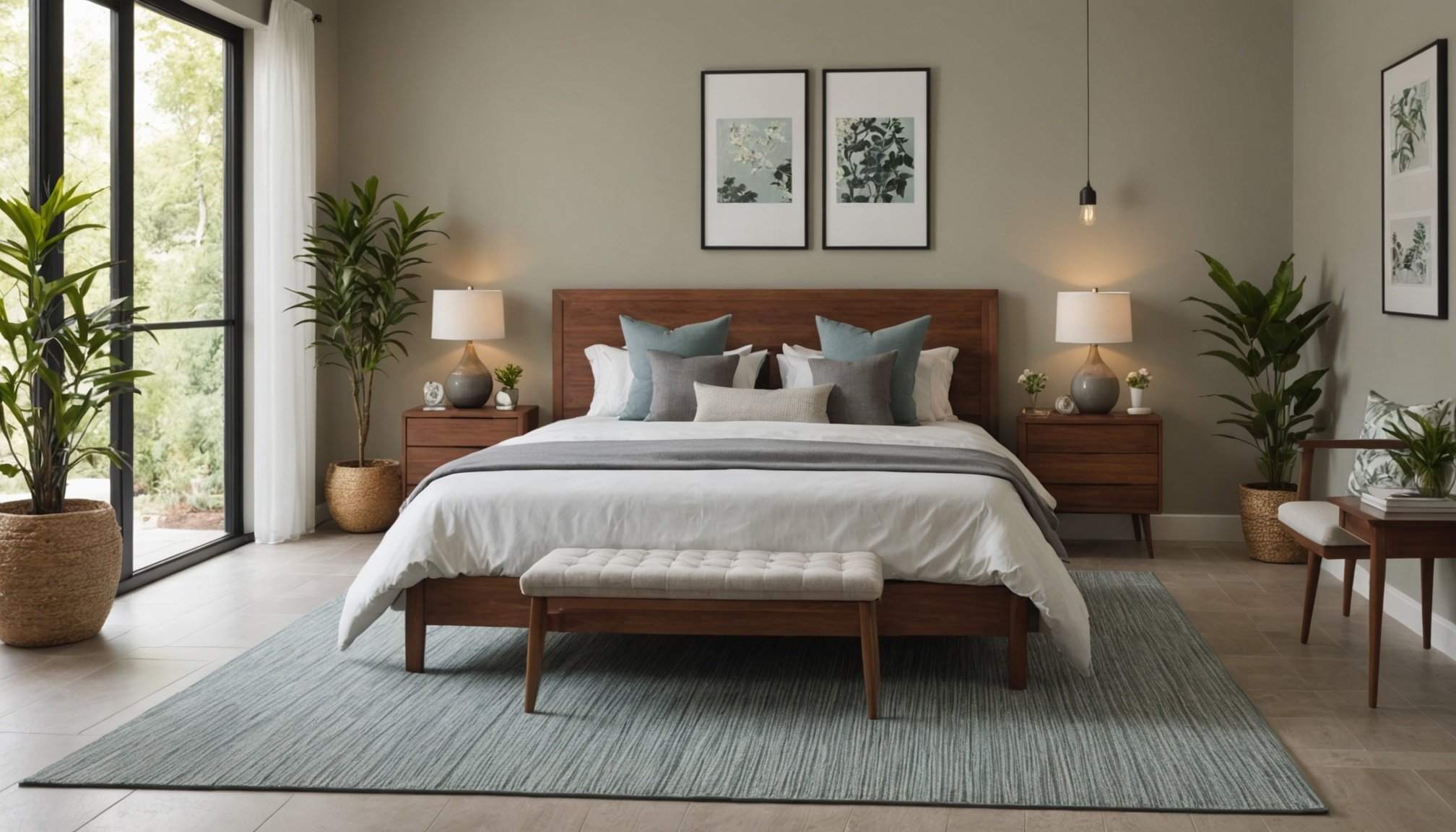Key Elements of a Tranquil Zen Guest Room
Creating a serene Zen guest room is about capturing simplicity and balance. One of the essential elements is a calming color palette, which sets the mood for relaxation. Opt for neutral tones like soft whites, beiges, and gentle greens. These colors promote tranquility by mimicking the calmness of nature.
The choice of furnishings also plays a crucial role. Prioritise minimalism: select simple, functional pieces that enhance relaxation. Low-sitting furniture, such as futons or platform beds, align with Zen philosophy and create openness in the space. Additionally, ensure the room has ample storage, minimizing clutter and fostering a sense of peace.
In parallel : Creative Ideas for Concealing a Play Zone in Your Family Living Room
Integrating natural elements is another cornerstone in Zen design. Incorporate materials like bamboo and natural wood to add warmth and authenticity. Decorating with stones or a small water feature can introduce the soothing aspects of nature. Consider adding plants such as bonsai or bamboo, which not only purify the air but also embody Zen principles of balance and harmony.
By focusing on these aspects, a Zen guest room becomes a haven of peace for any guest, inviting them to unwind in an atmosphere of natural simplicity.
Topic to read : Creating a Secure and Fun Play Space for Toddlers in Your Cozy Apartment: A Comprehensive Guide
Mindfulness Techniques for a Serene Atmosphere
In today’s fast-paced world, achieving a tranquil home environment can significantly enhance well-being. Practising mindfulness in design is an effective way to cultivate serenity. It involves deliberate choices that foster calmness and reduce stress.
Creating a Peaceful Entryway
The entryway sets the tone for a home, serving as the first welcome. To infuse mindfulness in design, use natural elements like wood or stone to connect with nature. Opt for a minimalist approach; declutter to maintain simplicity and serenity. A soft palette and gentle lighting can create an immediate sense of calm, ushering in a relaxing atmosphere.
Incorporating Meditation Spaces
Dedicating a space for meditation can greatly enhance mindfulness. Use neutral colours, comfortable cushions, or mats to create an inviting area. Introduce elements such as incense or a small zen garden to enrich the experience. These design choices encourage regular practice, seamlessly integrating mindfulness into your routine.
Designing for Disconnection
To promote mindfulness in design, limit distractions by creating tech-free zones. Arrange furniture to focus on conversation or a view, rather than screens. Consider soundproofing elements to minimise external noise, fostering an environment conducive to reflection and connection. This thoughtful design encourages meaningful interactions, contributing to a serene home.
Essential Decor Features for Serenity
Creating a tranquil environment is easily achievable with the right decor for relaxation. Selecting soothing artwork can set the tone for a serene ambiance. Choose pieces with calming colours, such as blues or greens, and gentle imagery that evokes peace. Landscapes, abstract designs, or art that depicts nature are excellent choices.
Soft lighting plays a crucial role in crafting a relaxing atmosphere. Incorporate lamps with dimming features or use fairy lights for a subtle glow. This can create an inviting warmth that soothes the senses, promoting relaxation in your space.
Adding scents through candles and diffusers enhances the sensory experience. Opt for fragrances like lavender, chamomile, or eucalyptus, known for their calming properties. Candles not only diffuse pleasant aromas but also add a visual element of flickering light, contributing to the relaxation decor. Diffusers, on the other hand, offer a consistent scent without the need for open flame.
These simple additions can transform any room into a haven of tranquillity. By carefully choosing artwork, lighting, and scents, you can create an oasis of peace in your home, allowing for an escape from the stress of everyday life.
Practical Tips for Optimizing Space
Creating a serene environment begins with space optimization for relaxation. Keeping your space free of chaos not only aids in relaxation but enhances functionality as well.
Decluttering for Peace of Mind
A clutter-free space is crucial for mental well-being. To optimise for relaxation, start by sorting belongings into categories: keep, donate, and discard. This method simplifies decision-making and reduces anxiety associated with clutter. Incorporate storage solutions like baskets or bins for a tidy, organised appearance. The immediate impact of decluttering results in improved focus and a calmer atmosphere.
Smart Furniture Arrangements
Furniture layout plays a vital role in maximising space. Prioritise pieces that serve dual purposes to conserve room and reduce clutter. Arranging furniture to encourage natural light can also make a room feel larger and more open. Consider arranging seating to create pathways that enhance flow and accessibility.
Multipurpose Solutions for Functionality
Choosing furniture with multiple uses is a key element of space optimization for relaxation. Items like ottomans with storage, sofa beds, or foldable desks are excellent for maintaining functionality without compromising space. These solutions allow for efficient use of the area while keeping it peaceful and versatile. By integrating such concepts, one can effortlessly transform any room into a harmonious and functional sanctuary.
Recommended Materials and Products
Creating a zen environment within your home relies heavily on the choice of materials and products. Textiles play a crucial role in enhancing comfort and calm. Soft, natural fibres like cotton, linen, and bamboo are excellent choices. These materials not only feel gentle against the skin but also enable excellent breathability, helping to maintain a serene atmosphere. Linen, in particular, has a natural texture that adds a subtle elegance to the space.
Exploring eco-friendly and sustainable options is not only beneficial for the environment but also contributes to a more harmonious living space. Bamboo textiles, for instance, are growing in popularity due to their rapid renewability and minimal environmental impact. Incorporating these materials helps cultivate a calming, earth-conscious environment.
Certain brands have become known for their focus on relaxation and sustainability. Products from companies like Parachute, known for their linen bedding, or Coyuchi, which offers organic cotton options, perfectly embody this ethos. They strike a balance between comfort, sustainability, and style, making it easier to infuse your home with a sense of zen tranquility. Remember, when selecting materials, prioritise those that create a soothing tactile experience while complementing your peace-driven lifestyle choices.
Visual Inspiration and Personal Anecdotes
Creating a zen guest room can be both a fulfilling and transformative experience. The key lies in drawing inspiration from various sources and understanding the personal touch behind each space.
Before-and-After Transformations
Before-and-after transformations can serve as powerful examples of how a space embodying chaos can become a sanctuary of balance and peace. Imagine a cluttered guest room infused with neutral colours, minimalist furniture, and soft textures. The room should not only look serene but feel calm, with particular attention paid to natural lighting and efficient space utilisation.
Real-Life Examples of Zen Spaces
Explore real-life examples for inspiration. One might take a page from a small, suburban apartment where a corner is transformed into a tranquil reading nook. This was achieved by using earthy tones, simple decor such as a single potted plant, and a cosy floor mat.
Stories of Mindful Spaces and Their Impact
Personal anecdotes reveal the profound impact of mindful spaces. For instance, a family reports that their newly redesigned zen-inspired guest room has become the most sought-after spot in their home, fostering relaxation and encouraging meaningful conversations among visitors. These stories highlight how designing with intention can deeply affect the environment and those who inhabit it.











